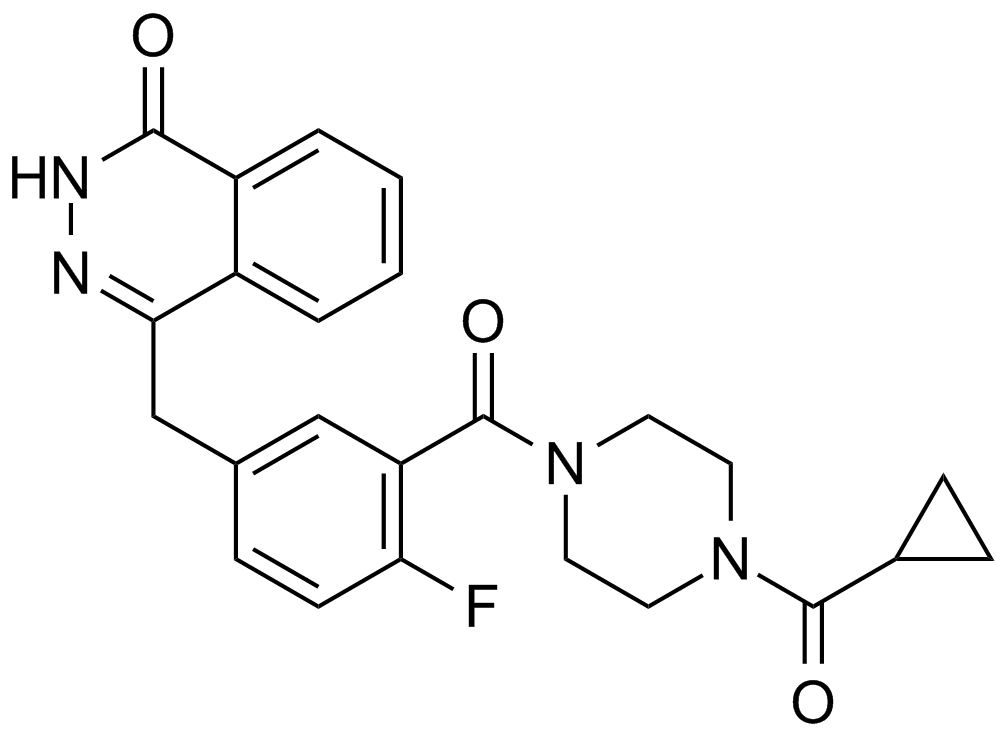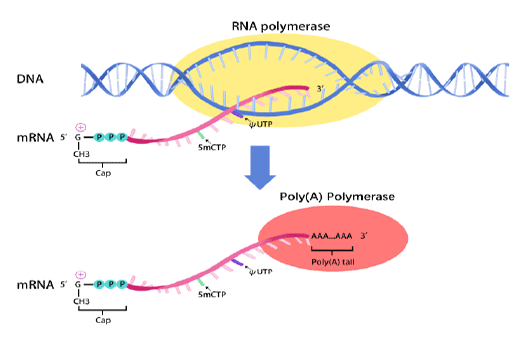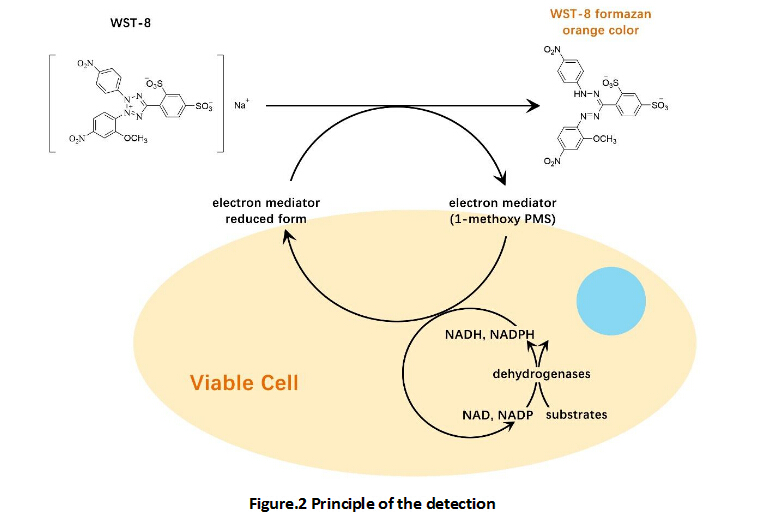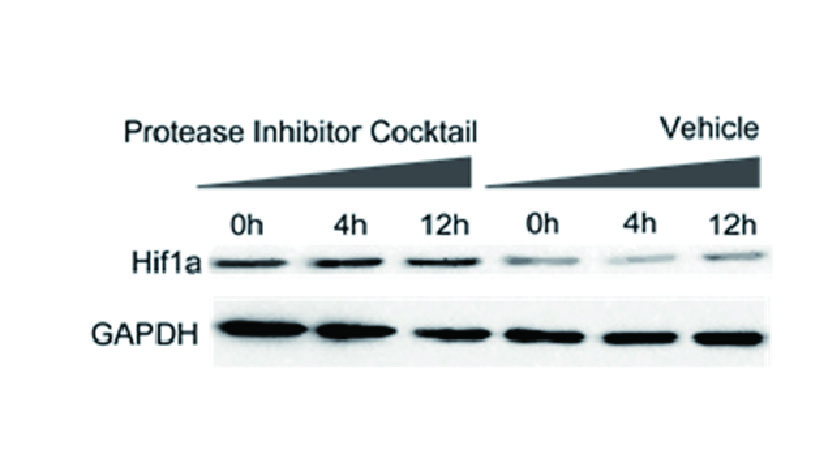Olaparib (AZD2281, Ku-0059436) [763113-22-0]
Marca : APExBIO Technology
Solicitar mais informações
Por favor, faça login para usar este recurso.
Olaparib (AZD2281, Ku-0059436)
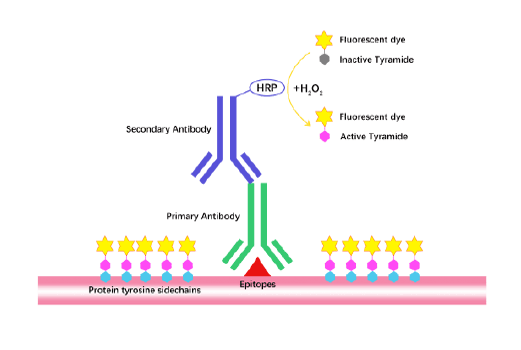
Tyramide Signal Amplification (TSA)
TSA (Tyramide Signal Amplification), used for signal amplification of ISH, IHC and IC etc.
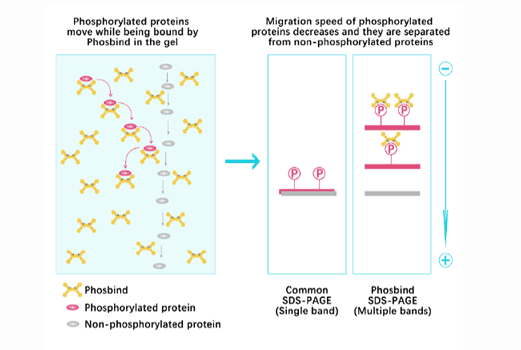
Phos Binding Reagent Acrylamide
Separation of phosphorylated and non-phosphorylated proteins without phospho-specific antibody
Background
Olaparib (4-(3-4-fluorophenyl) methyl-1(2H)-one), as known as AZD2281 or KU0059436, is a novel, selective and potent inhibitor of both poly adenosine diphosphate-ribose polymeras-1 (PARP-1) and poly adenosine diphosphate-ribose polymeras-2 (PARP-2). Having been successfully used in the treatment of tumors harboring BRCA mutations, olaparib strongly inhibits the growth of BRCA2-deficient mouse mannary tumor cell lines demonstrating cytotoxicity. In previous researches treating non-small cell lung carcinoma (NSCLC), olaparib increased the radiation sensitivity of NSCLC cells, grown as xenografts in nude mice, following radiation and increased vascular perfusion in Calu-6 tumors established in a dorsal window chamber (DWC) model.
Reference
Joana M. Senra, Brian A. Telfer, Kim E. Cherry, Cian M. McCrudden, David G. Hirst, Mark J. O’Connor, Stephen R. Wedge, and Ian J. Stratford. Inhibition of poly(ADP-ribose) polymerase-1 by olaparib (AZD2281) increases the radiosensitivity of a lung tumor xenograft. Mol Cancer Ther. 2011; 10(10): 1949-1958
Bastiaan Evers, Rinske Drost, Eva Schut, Michiel Bruin, Eline vab der Burg, Patrick W.B. Derksen, Henne Holstege, Xiaoling Liu, Ellen van Drunen, H. Berna Beverloo, Graeme C. M. Smith, Niall M. B. Martin, Alan Lau, Mark J. O’Connor, and Jos Jonkers. Selective inhibition of BRCA2-deficient mammary tumor cell growth by AZD2281 and Cisplatin. Clin Cancer Res 2008; 14:3916-3925
Product Citation
- 1. Maria V Sukhanova, Rashid O Anarbaev, et al. "Biologically Relevant Polyamines, Divalent Metal Cations, and Structure of Poly(ADP-Ribose) All Control Microphase Separation of FUS with Poly(ADP-Ribosyl)ated PARP1." Biology and Life Sciences. 03 October 2024
- 2. Maria V Sukhanova, Rashid O Anarbaev, et al. "Divalent and multivalent cations control liquid-like assembly of poly (ADP-ribosyl) ated PARP1 into multimolecular associates in vitro." Commun Biol. 2024 Sep 15;7(1):1148 PMID: 39278937
- 3. Yinan Jiang, Shuting Huang, et al. "Targeting the Cdc2‐like kinase 2 for overcoming platinum resistance in ovarian cancer." MedComm (2020). 2024 Apr 13;5(4):e537. PMID: 38617434
- 4. Apoorva Uboveja, Zhentai Huang, et al. "αKG-mediated carnitine synthesis promotes homologous recombination via histone acetylation." bioRxiv. 2024 Feb 11:2024.02.06.578742 PMID: 38370789
- 5. Andrew N. Blackford, et al. "BLM and BRCA1-BARD1 coordinate complementary mechanisms of joint DNA molecule resolution." Mol Cell. 2024 Feb 15;84(4):640-658.e10. PMID: 38266639
- 6. Seema Khattri Bhandari. "Effect of Ligase I deficiency on replication fork and chromatin." University of New Mexico. March 21, 2023.
- 7. Judit Jimenez-Sainz, Joshua Mathew, et al. "BRCA2 BRC missense variants disrupt RAD51-dependent DNA repair." Elife. 2022 Sep 13;11:e79183. PMID: 36098506
- 8. Yinyin Xie, Yannan Zhang, et al. "The coupling of mitoproteolysis and oxidative phosphorylation enables tracking of an active mitochondrial state through MitoTimer fluorescence." Redox Biol. 2022 Oct;56:102447. PMID: 36027677
- 9. Leonie Schürmann, Lena Schumacher, et al. "Inhibition of the DSB repair protein RAD51 potentiates the cytotoxic efficacy of doxorubicin via promoting apoptosis-related death pathways." Cancer Lett. 2021 Nov 1;520:361-373. PMID: 34389435
- 10. Fujiao Nie, Jiazhao Yan, et al. "Effect of Shuangdan Mingmu capsule, a Chinese herbal formula, on oxidative stress-induced apoptosis of pericytes through PARP/GAPDH pathway." BMC Complement Med Ther. 2021 Apr 10;21(1):118. PMID: 33838689
- 11. Asha Sinha, Sachin Katyal, et al. "PARP-DNA trapping ability of PARP inhibitors jeopardizes astrocyte viability: Implications for CNS disease therapeutics." Neuropharmacology. 2021 Apr 1;187:108502. PMID: 33631119
- 12. Phoebe McCrorie, Jatin Mistry, et al. "Etoposide and olaparib polymer-coated nanoparticles within a bioadhesive sprayable hydrogel for post-surgical localised delivery to brain tumours." Eur J Pharm Biopharm. 2020 Oct 14;S0939-6411(20)30305-2. PMID: 33068736
- 13. Kim DS, Camacho CV, et al. "Activation of PARP-1 by snoRNAs Controls Ribosome Biogenesis and Cell Growth via the RNA Helicase DDX21." Mol Cell. 2019 Jul 9. pii: S1097-2765(19)30476-9. PMID: 31351877
- 14. Singatulina AS, Hamon L, et al. "PARP-1 Activation Directs FUS to DNA Damage Sites to Form PARG-Reversible Compartments Enriched in Damaged DNA." Cell Rep. 2019 May 7;27(6):1809-1821.e5. PMID: 31067465
- 15. Kong X, Cruz GMS, et al. "Biphasic recruitment of TRF2 to DNA damage sites promotes non-sister chromatid homologous recombination repair." J Cell Sci. 2018 Dec 5;131(23). pii: jcs219311. PMID: 30404833
- 16. Cheriyan VT, Alsaab H, et al. "A CARP-1 functional mimetic compound is synergistic with BRAF-targeting in non-small cell lung cancers." Oncotarget. 2018 Jul 3;9(51):29680-29697. PMID: 30038713
- 17. Li N, Yang L, et al. "BET bromodomain inhibitor JQ1 preferentially suppresses EBV-positive nasopharyngeal carcinoma cells partially through repressing c-Myc." Cell Death Dis. 2018 Jul 9;9(7):761. PMID: 29988031
- 18. Coyle JP, Rinaldi RJ, et al."Reduced oxygen tension culturing conditionally alters toxicogenic response of differentiated H9c2 cardiomyoblasts to acrolein." Toxicol Mech Methods. 2018 Mar 22:1-39. PMID: 29564938
- 19. Kong X, Cruz GMS, et al. "Laser Microirradiation to Study In Vivo Cellular Responses to Simple and Complex DNA Damage." J Vis Exp. 2018 Jan 1;(131). PMID: 29443023
- 20. Iniguez AB, Stolte B, et al. "EWS/FLI Confers Tumor Cell Synthetic Lethality to CDK12 Inhibition in Ewing Sarcoma." Cancer Cell. 2018 Feb 12;33(2):202-216.e6. PMID: 29358035
- 21. Xiangduo Kong,Gladys Mae Saquilabon Cruz,et al."Biphasic recruitment of TRF2 to DNA damage sites promotes non-sister chromatid homologous recombination repair."bioRxiv. April 20.
- 22. Mackay DR, Howa AC, et al. "Nup153 and Nup50 promote recruitment of 53BP1 to DNA repair foci by antagonizing BRCA1-dependent events." J Cell Sci.2017 Oct 1;130(19):3347-3359. PMID: 28751496
- 23. Skvarova Kramarzova K, Osborn MJ, et al. "CRISPR/Cas9-Mediated Correction of the FANCD1 Gene in Primary Patient Cells." Int J Mol Sci. 2017 Jun 14;18(6). pii: E1269. PMID: 28613254
- 24. Gao Y, Li C, et al. "SSRP1 Cooperates with PARP and XRCC1 to Facilitate Single-Strand DNA Break Repair by Chromatin Priming." Cancer Res.2017 May 15;77(10):2674-2685. PMID: 28416484
- 25. Raymond D, Harbison, Ph.D, et al. "The Influence of Oxygen Tension and Glycolytic and Citric Acid Cycle Substrates in Acroleininduced Cellular Injury in the Differentiated H9c2 Cardiac Cell Model."University of South Florida. 2016 Nov.
- 26. Höhn A, Krüger K, et al. "Distinct mechanisms contribute to acquired cisplatin resistance of urothelial carcinoma cells." Oncotarget. 2016 Jul 5;7(27):41320-41335. PMID: 27191498
- 27. Cruz, Gladys Mae Saquilabon, et al. "Femtosecond near-infrared laser microirradiation reveals a crucial role for PARP signaling on factor assemblies at DNA damage sites." Nucleic acids research (2015): gkv976. PMID: 26424850
Chemical Properties
| Storage | Store at -20°C |
| M.Wt | 434.46 |
| Cas No. | 763113-22-0 |
| Formula | C24H23FN4O3 |
| Synonyms | AZD 2281,AZD-2281 |
| Solubility | ≥21.72 mg/mL in DMSO; insoluble in EtOH; insoluble in H2O |
| Chemical Name | 4-[[3-[4-(cyclopropanecarbonyl)piperazine-1-carbonyl]-4-fluorophenyl]methyl]-2H-phthalazin-1-one |
| SDF | Download SDF |
| Canonical SMILES | C1CC1C(=O)N2CCN(CC2)C(=O)C3=C(C=CC(=C3)CC4=NNC(=O)C5=CC=CC=C54)F |
| Shipping Condition | Small Molecules with Blue Ice, Modified Nucleotides with Dry Ice. |
| General tips | We do not recommend long-term storage for the solution, please use it up soon. |
Protocol
| Cell experiment: [1] | |
| Cell lines | Normal LCL cells ATM-null LCL cells |
| Preparation method | The solubility of this compound in DMSO is >10 mM. General tips for obtaining a higher concentration: Please warm the tube at 37 °C for 10 minutes and/or shake it in the ultrasonic bath for a while.Stock solution can be stored below -20°C for several months. |
| Reaction Conditions | 10 μM, 1 hour |
| Applications | The sensitivity of cells to olaparib is mediated by absence of Ataxia Telangiectasia Mutated (ATM) activity. Immunoblot analysis revealed that in ATM wild-type LCLs, but not ATM null LCLs, phosphorylation of the ATM-dependent targets ATM S1981 and SMC1 S966 was induced in a dose-dependent manner by olaparib. |
| Animal experiment: [1] | |
| Animal models | Granta-519–engrafted NOD/SCID mice |
| Dosage form | Intraperitoneal injection, 50 mg/kg/d, for 14 days |
| Applications | Analysis of the percentage of human CD45 staining by FACS analysis revealed a significant reduction in the percentage of Granta-519 cells in the bone marrow and a trend toward reduced tumor cell load in the spleen of mice treated with olaparib compared with those receiving vehicle alone. |
| Other notes | Please test the solubility of all compounds indoor, and the actual solubility may slightly differ with the theoretical value. This is caused by an experimental system error and it is normal. |
| References: [1] Weston V J, Oldreive C E, Skowronska A, et al. The PARP inhibitor olaparib induces significant killing of ATM-deficient lymphoid tumor cells in vitro and in vivo. Blood, 2010, 116(22): 4578-4587. | |
Biological Activity
| Olaparib (AZD2281, KU0059436) is a potent inhibitor of PARP1 and PARP2 with IC50 of 5 and 1 nM, respectively. | ||||||
| Targets | PARP1 | PARP2 | ||||
| IC50 | 5 nM | 1 nM | ||||
Quality Control
Related Biological Data

Related Biological Data

Related Biological Data

Related Biological Data

Related Biological Data

Related Biological Data





